Overview
The Mars 2020 mission spacecraft, carrying the Perseverance rover, launched from Cape Canaveral, Florida, on July 30, 2020. The spacecraft will arrive at Mars about six-and-a-half months later, on Feb. 18, 2021.
Key phases of the Mars 2020 mission are launch, cruise, arrival (also known as entry, descent, and landing), and Mars surface operations.
During a prime mission that will last one Mars year (about 687 Earth days), Perseverance’s exploration of Jezero Crater will address high-priority science goals for Mars exploration. A key objective for Perseverance’s mission on Mars is astrobiology, including the search for signs of ancient microbial life. The rover will also characterize the planet’s climate and geology, pave the way for human exploration of the Red Planet, and be the first planetary mission to collect and cache Martian rock and regolith (broken rock and dust).
The Ingenuity Mars Helicopter, a technology demonstration, is also riding along to Mars, attached to the belly of Perseverance. More information about its mission is in the helicopter’s press kit.
Launch
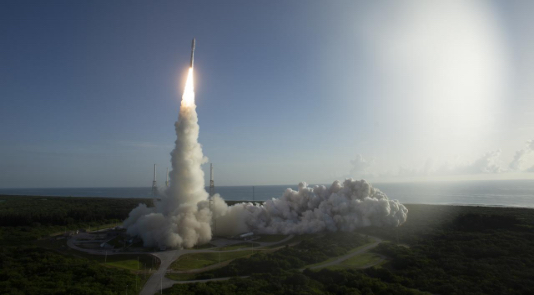 Image credit: NASA/Joel Kowsky | Full Image and Caption
Image credit: NASA/Joel Kowsky | Full Image and Caption
The Mars 2020 spacecraft, with the Perseverance rover and the Ingenuity Mars Helicopter inside, lifted off from Space Launch Complex 41 at Cape Canaveral Air Force Base on July 30, 2020, at 7:50 a.m. EDT (4:50 a.m. PDT) aboard a two-stage United Launch Alliance (ULA) Atlas V 541 launch vehicle.
Why did Perseverance launch in the summer of 2020? As Earth and Mars race around the Sun, with Earth on the inside track, Earth laps Mars about once every 26 months. Launch opportunities to Mars occur at the same frequency, when the planets are positioned so that a spacecraft launched from Earth will be on a relatively short track to Mars (taking on the order of months rather than years to arrive at Mars). This planetary clockwork, plus the launch vehicle’s lift capability, the spacecraft’s mass, and the desired geometry and timing for the landing on Mars were all factors in determining the range of possible launch dates.
One priority for choosing this launch period and arrival date was to make sure Perseverance could land when NASA orbiters at Mars will be passing over the landing site. Such scheduling allows the orbiters to receive radio transmissions from the spacecraft carrying Perseverance during its descent through the atmosphere and landing. Landing on Mars is always difficult, and NASA prioritizes communications during this critical event.
Interplanetary Cruise
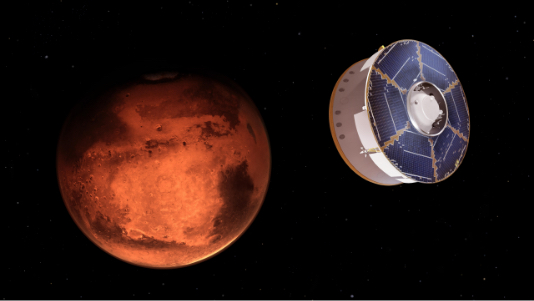 Image credit: NASA/JPL-Caltech | Full Image and Caption
Image credit: NASA/JPL-Caltech | Full Image and Caption
Perseverance requires 203 days to travel about 293 million miles (471 million kilometers) from Earth to Mars. This is the cruise phase of the mission. The final 45 days of the cruise phase make up the approach subphase.
During cruise, the Perseverance rover and its descent stage are protected inside a capsule known as an aeroshell, which is attached to the ring-shaped, solar-powered cruise stage. For more information about the cruise stage, aeroshell, and descent stage, visit the Spacecraft section of this press kit.
During cruise, engineers perform a series of events to check the spacecraft subsystems and instruments. They also plan to execute four trajectory correction maneuvers. For these feats of navigation, mission team members estimate where the Mars 2020 spacecraft is and where it will be, and precisely fire the cruise stage thrusters to alter its path to make sure it arrives at a particular location at the top of the Martian atmosphere. These trajectory correction maneuvers will not significantly change the time Perseverance lands on Mars.
The final 45 days leading up to landing constitute the approach subphase, which focuses primarily on navigation activities and preparing the vehicle for entry, descent, and landing. Two trajectory correction maneuvers are planned during this subphase for any last adjustments (if needed) to the entry target.
Entry, Descent, and Landing
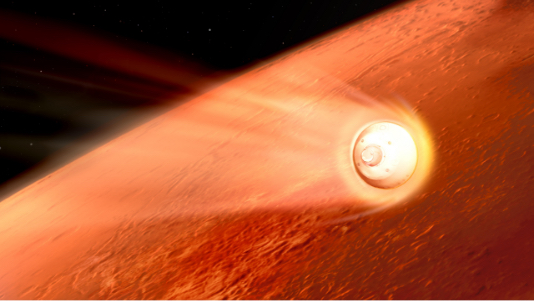 Image credit: NASA/JPL-Caltech | Full image and caption
Image credit: NASA/JPL-Caltech | Full image and caption
The intense entry, descent, and landing (EDL) phase begins when the spacecraft reaches the top of the Martian atmosphere, traveling at about 12,100 mph (19,500 kph). EDL ends about seven minutes later, with the rover stationary on the Martian surface. Many engineers refer to the time it takes to land on Mars as the “seven minutes of terror.” Not only is the choreography of EDL complex, but the time delay involved in communicating with Earth means that the spacecraft has to accomplish this choreography all by itself.
While all landings on Mars are difficult, Perseverance is landing in the most challenging terrain ever targeted. Jezero Crater is a 28-mile-wide (45-kilometer-wide) impact basin with an intriguing ancient river delta as well as steep cliffs, sand dunes, boulder fields, and smaller impact craters. Landing at Jezero Crater is only possible because of new EDL technologies such as Range Trigger and Terrain-Relative Navigation. (Find more information on both below.)
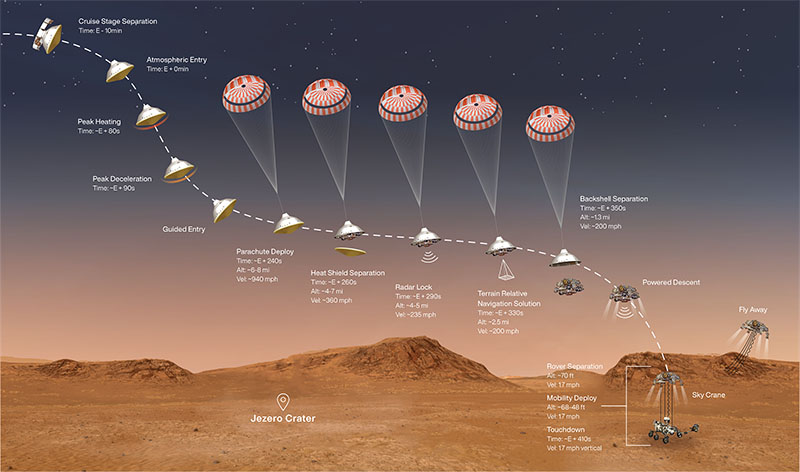 Image credit: NASA/JPL-Caltech | + View Larger Image | + View Metric Version
Image credit: NASA/JPL-Caltech | + View Larger Image | + View Metric Version
Key Milestones
If all goes as planned, engineers expect to receive notice of Perseverance’s completion of these milestones at the times below. Landing time may vary by plus or minus one minute because of a variety of factors in the dynamic environment of a Mars landing, such as uncertainties about the Red Planet’s atmosphere. Because of the distances the signals have to travel from Mars to Earth, these events take place on the actual spacecraft at Mars (known as spacecraft event time) 11 minutes and 22 seconds earlier than what is noted here.
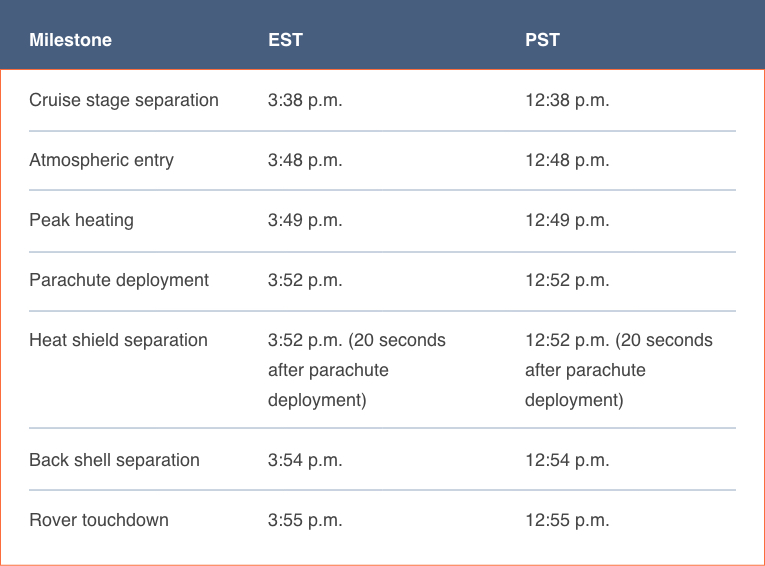
Atmospheric Entry
At about 3:38 p.m. EST (12:38 p.m. PST) – 10 minutes before entering the Martian atmosphere – the Mars 2020 spacecraft will shed the cruise stage that helped fly Perseverance and Ingenuity to Mars. The spacecraft will manipulate its descent into Mars’ atmosphere using a technique called guided entry to reduce the size of the targeted ellipse-shaped landing area on Mars while compensating for variations in the density of the Martian atmosphere and drag on the vehicle. During guided entry, small thrusters on the back of the aeroshell will adjust the angle and direction of lift, enabling the spacecraft to control how far downrange it is flying.
Peak heating occurs about 75 seconds after atmospheric entry, when the temperature at the external surface of the heat shield will reach about 2,370 degrees Fahrenheit (about 1,300 degrees Celsius). About three minutes later, Perseverance’s parachute is expected to deploy with the help of a new technique called Range Trigger.
During EDL, Range Trigger will autonomously update the deployment time for the parachute based on navigation position. It will calculate the spacecraft’s distance to the landing target and open the parachute at the ideal time for the spacecraft to hit its mark. The result: a smaller, more precise landing ellipse, or target landing area. The landing ellipse for Perseverance is 10 times smaller in area than the Curiosity rover’s in 2012 and almost 300 times smaller than that of the first Mars rover, Sojourner, in 1997.
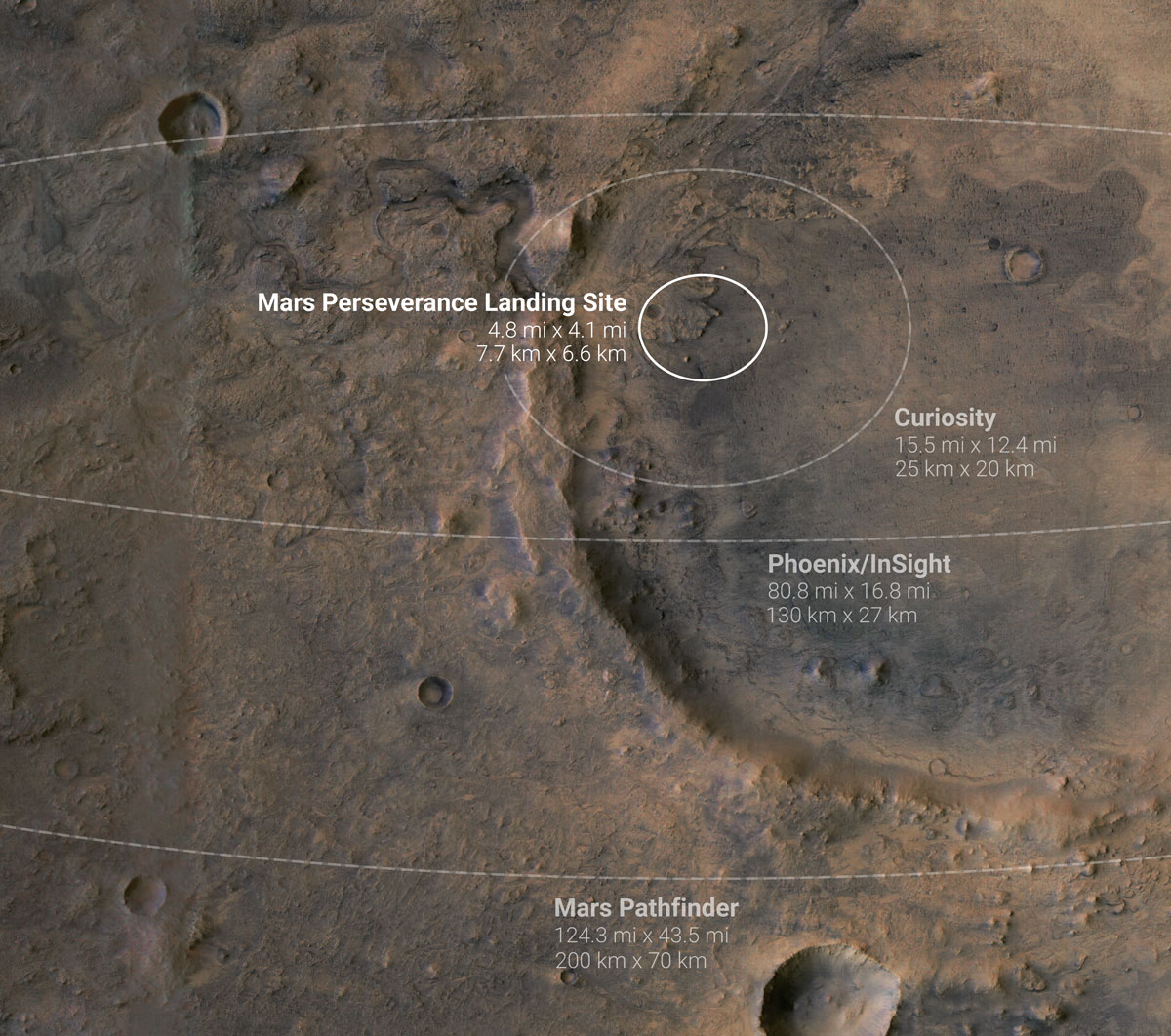 Image credit: NASA/JPL-Caltech | + View Larger Image
Image credit: NASA/JPL-Caltech | + View Larger Image
The parachute, which is 70.5 feet (21.5 meters) in diameter, deploys about 240 seconds after entry, at an altitude of about 7 miles (11 kilometers) and a velocity of about 940 mph (1,512 kph). Twenty seconds after parachute deployment, the heat shield separates and drops away, revealing a radar and cameras that feed into the other new landing technology, called Terrain-Relative Navigation. Terrain-Relative Navigation is a kind of autopilot that can quickly figure out the spacecraft’s location over the Martian surface and select the best reachable safe landing target.
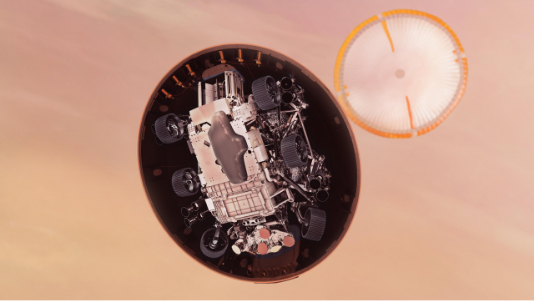 Image credit: NASA/JPL-Caltech | + View Larger Image
Image credit: NASA/JPL-Caltech | + View Larger Image
Previous Mars missions have relied on radar to help the spacecraft determine how far they are from the ground and how fast they are going during landing. Perseverance has data from a radar and something new called the Lander Vision System. The radar actively pings the ground from the time the heat shield comes off (about 4 to 5 miles, or 7 to 8 kilometers, above the surface) all the way to touchdown. The Lander Vision System, part of the Terrain-Relative Navigation technology, operates when the spacecraft is between about 2.6 to 1.4 miles, or 4.2 to 2.2 kilometers, above the ground. Terrain-Relative Navigation can change the rover’s touchdown point by up to 2,000 feet (600 meters).
The Lander Vision System’s job is to determine the rover’s position, handling different possible terrain conditions, within an accuracy of about 130 feet (40 meters) in less than 10 seconds. It has a downward-facing camera that takes image after image of the ground rushing up to meet the rover and an onboard computer (the Vision Compute Element) that processes the images and spits out locations. After the camera turns on, the Lander Vision System uses an initial 5 seconds to take three images and process them to calculate a rough position relative to the Martian surface. Then, using that initial location solution, it takes additional images and processes them every second, deriving locations on a finer scale. The Vision Compute Element sends a stream of these location calculations to the main rover brain (the Rover Compute Element). (More detail about these computers is in the Spacecraft section of this press kit.) Around the same time the rover separates from the back shell (and its parachute), the Rover Compute Element uses the last accurate location calculation from the Lander Vision System to pick the safest reachable landing site, thereby completing Terrain-Relative Navigation activities.
At the time the powered descent vehicle – the combination of the descent stage and the rover – separates from the back shell it is about 1.3 miles (2.1 kilometers) above the surface.
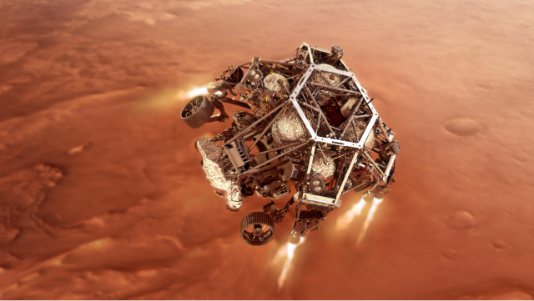 Image credit: NASA/JPL-Caltech | + View Larger Image
Image credit: NASA/JPL-Caltech | + View Larger Image
The eight throttleable retrorockets on the descent stage, called Mars landing engines, not only help the spacecraft fly to a safe landing site, but also help slow the spacecraft. When the powered descent phase begins, the spacecraft is traveling at about 190 mph (306 kph) 6,900 feet (2,100 meters) above the ground. It slows to 1.7 mph (2.7 kph) by the time it’s about 66 feet (20 meters) above the surface.
When the descent stage determines it is 65 feet (20 meters) over the landing area designated by Terrain-Relative Navigation, it initiates the sky crane maneuver: Nylon cords spool out to lower the rover 25 feet (7.6 meters) below the descent stage. When the spacecraft senses the rover has touched down in Jezero Crater, pyrotechnically fired blades sever the cords, and the descent stage flies a safe distance away before impacting the Martian surface.
Confirmation of Landing Milestones
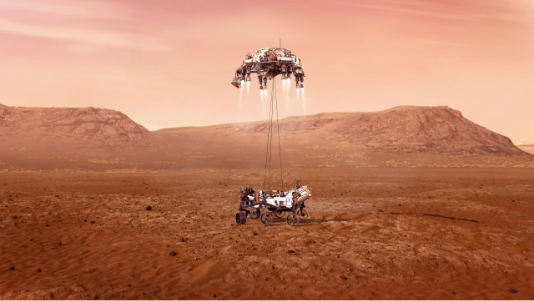 Image credit: NASA/JPL-Caltech | Full image and caption
Image credit: NASA/JPL-Caltech | Full image and caption
NASA’s Mars Reconnaissance Orbiter (MRO) will be flying overhead during Perseverance’s landing on Mars. If the communications relay system from Mars to Earth works as expected, MRO will receive telemetry (detailed engineering data) from the lander and then relay it to NASA’s Deep Space Network (DSN) antennas on Earth. This will allow mission controllers to confirm the spacecraft has touched down at around 3:55 p.m. EST (12:55 p.m. PST). MRO has been newly configured to send telemetry to Earth throughout the landing timeline in 5-second packets, with about a 16-second latency. (For more on this special relay system, called “pseudo bent pipe,” read the Telecommunications section of this press kit.) The DSN’s antenna complex near Madrid, Spain, will be lead during entry, descent, and landing, with the complex in Goldstone, California, providing support.
Perseverance will also be sending tones (simpler signals without detailed engineering data) in the X-band frequency and an ultrahigh frequency (UHF) dial-tone-like carrier signal directly back to Earth. The tones will enable the engineers to determine that the rover has completed some key milestones, and the carrier signal will enable engineers to determine that the spacecraft is still functioning. The X-band tones will be received by DSN antennas. The UHF carrier signal is expected to be received directly from the rover by the Green Bank Observatory in West Virginia and the Effelsberg Observatory in Germany.
Because the rover is landing at a time of day when the landing site (Jezero Crater) doesn’t have a direct line of sight back to Earth, both of these direct-to-Earth transmissions are expected to end a little after back shell separation, about one minute before touchdown.
NASA engineers always have backup plans, so they have scheduled MRO to replay the detailed engineering data 10 and 15 minutes after landing for additional chances to study the information. NASA’s Mars Atmosphere and Volatile EvolutioN (MAVEN) orbiter will also be flying by when Perseverance is landing and receiving the same detailed engineering data as MRO. Unlike MRO, MAVEN is not configured to be able to receive data from Mars and transmit it to Earth immediately, however. What’s more, it captures the data in a form that requires additional processing when they reach Earth. As a result, mission controllers expect the MAVEN data to be readable on Earth for the first time about 10 hours after landing.
Surface Phase
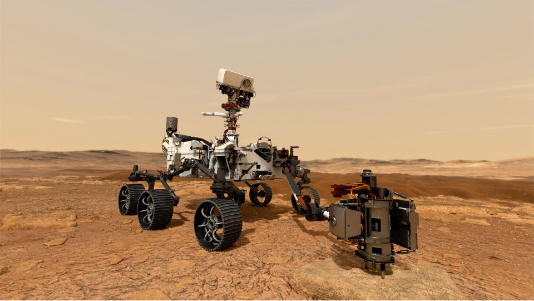 Image credit: NASA/JPL-Caltech | Full image and caption
Image credit: NASA/JPL-Caltech | Full image and caption
The rover is expected to touch down in the Martian afternoon – at 3:53 p.m. local mean solar time. Soon after, the rover’s computer switches from entry, descent, and landing mode to surface mode. This initiates a series of autonomous activities for the first Martian day on the surface of the Red Planet.
First Images
One of Perseverance’s first activities in surface mode is to take a pair of pictures with the engineering cameras – known as the Hazard Cameras, or Hazcams – on the front and rear of the rover. Hazcams have clear covers over their lenses to protect them from dust that gets kicked up during landing. The first two images – front and rear Hazcam images – will be taken through these dust covers within minutes after landing. The reduced-resolution version of these images, known as “thumbnails,” are expected to become available the same day. Depending on the terrain where Perseverance lands, MRO, the rover’s communications relay, may move below the horizon from the rover’s point of view shortly after landing, limiting communications with that satellite.
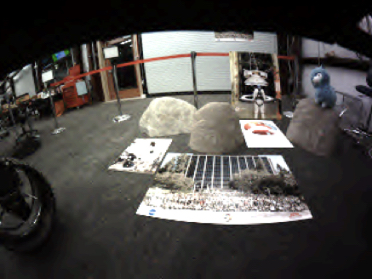 A low-resolution thumbnail image taken by the Perseverance engineering model’s front Hazcam during a practice landing session. Image credit: NASA/JPL-Caltech | + View Larger Image
A low-resolution thumbnail image taken by the Perseverance engineering model’s front Hazcam during a practice landing session. Image credit: NASA/JPL-Caltech | + View Larger Image
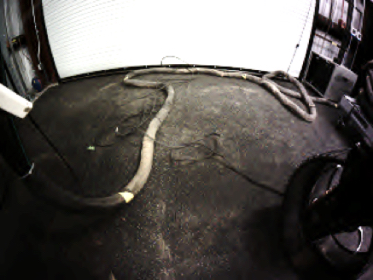 A low-resolution thumbnail image transmitted by the Perseverance engineering model’s rear Hazcam during a practice landing session. Image credit: NASA/JPL-Caltech | + View Larger Image
A low-resolution thumbnail image transmitted by the Perseverance engineering model’s rear Hazcam during a practice landing session. Image credit: NASA/JPL-Caltech | + View Larger Image
Later on landing day, quarter-resolution versions and stereo images from the Hazcams with the covers open will become available. By the following morning, a high-resolution image of the wheels from the Hazcams and one image from a camera looking down at the rover from the descent stage are expected to be available.
Over the next couple days and through the weekend, Perseverance will take additional pictures of the landing site and rover hardware, including from the Navigation Cameras (Navcams) and Mastcam-Z on the remote sensing mast (the rover’s “head”). The rover is also expected to be transmitting additional images from the EDL cameras and microphone, allowing the public to see and hear what it was like to land on Mars.
More information about the cameras is in the Spacecraft section.
Checkout
Perseverance’s first Martian day on the surface of the Red Planet is known as Sol 0.
A sol is a Martian day, which is 24 hours, 39 minutes, 35.244 seconds. (Perseverance team members tend to refer to sols rather than Earth days during operations since the rover will be working during the Martian day and “sleeping” during the Martian night.) The prime mission for the Perseverance rover is one Martian year on the surface. One Martian year is 687 Earth days, or 669 sols.
Perseverance’s first images are part of a planned 90-sol initial checkout period. The mission team will perform tests of all the rover’s parts and science instruments to ensure everything – including the team – is ready for surface operations. For about 90 sols, the operations team will be working on Mars time, which means they will be setting their clocks to the Martian day. This allows them to respond quickly to any issue the rover may have during its workday and to make sure revised instructions are ready for the next sol.
Working on Mars time also means that team members will move their start times 40 minutes later each day. Eventually, team members will be waking up in the middle of the night to start their shifts. Because living on Mars time makes daily life on Earth much more challenging, the team does this only for a limited period.
The first part of the checkout period is called the commissioning phase. During this period, the rover unpacks its instruments, upgrades its software, and goes for a test drive.
Here’s what to expect in the first 30 sols after landing:
- Images of the rover’s wheels just after touching down (first with dust covers on, then with covers off).
- Deployment of mast and high-gain antenna.
- Images of the landing site and the rover’s deck.
- Update of rover flight software.
- Health checks performed on all instruments.
- Short, approximately 16-foot (5-meter) drive test.
- Unstowing of the robotic arm and “calisthenics,” testing its movement.
- Jettisoning of the belly pan beneath the rover, which protects the sampling system and internal robotic arm during landing.
- PIXL and SHERLOC instrument images of their calibration targets.
- Deployment of the sample-tube-handling robotic arm inside the rover’s body and system checkouts.
The commissioning phase is expected to end about 30 sols after landing, depending on how well the activities go. Milestones after that include:
- Driving to the helicopter flight zone.
- Jettisoning of the debris shield, which protects the Ingenuity helicopter during landing.
Helicopter Flight Testing
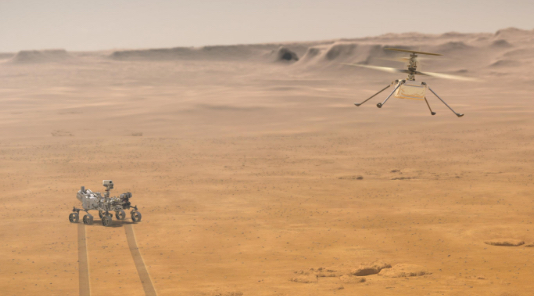 Image credit: NASA/JPL-Caltech | Full image and caption
Image credit: NASA/JPL-Caltech | Full image and caption
After mission controllers have determined that rover systems are functioning as desired, Perseverance will find a flat area to serve as a helipad for the Ingenuity Mars Helicopter technology demonstration. In the first months after landing, if all goes well, the rover will deploy Ingenuity in the center of this area and drive a safe distance (about 330 feet, or 100 meters) away from it. The helicopter’s team will then have up to 30 sols to perform a series of flight tests on Mars, the first time powered, controlled flight has been attempted on another planet.
The rover will act as a communications relay between Ingenuity, Mars orbiters, and mission controllers on Earth. Perseverance’s MEDA instrument will provide meteorological information (including data on airborne dust), while its Mastcam-Z and Navigation Cameras will collect still images of Ingenuity – and possibly a video or two. The rover’s two microphones (one located on the SuperCam instrument; the other, on its chassis) will attempt to pick up the sounds of the flight operations.
During the Helicopter Deployment Phase and the subsequent 30-sol technology demonstration window, there will likely be segments of time where no direct support of helicopter operations is required of the rover. During these periods, the Mars 2020 mission team will pursue science opportunities with its other instruments.
Find more information in the Ingenuity Mars Helicopter press kit.
Surface Operations
At the end of these experimental helicopter flights, Perseverance will begin its surface operations phase, when the team will carry out its ambitious science mission: searching for signs of ancient microbial life, characterizing the climate and geology of Mars, and collecting carefully selected and documented samples for future return to Earth. Find more about Perseverance’s science objectives in the Science section of this press kit.
Exploration of the Martian surface is led by the rover’s science team. To maximize the science being conducted in the time available, the mission team plans a science strategy in advance while building in the flexibility to respond to new discoveries as scientists study the data. The science team has a variety of tools at its disposal, starting with data from NASA’s Mars orbiters. The science team has studied Jezero Crater extensively for years with these tools, mapping out key places, called campaign locations, they want to study with Perseverance. Campaign locations include individual outcrops, or rover stops. As data comes in with finer and finer resolution from the rover’s science instruments, the science team will make progressively more detailed decisions about what data to collect, what samples to cache, and where to go next.
Perseverance is expected to cover more ground than any previous Mars rover. Much of its driving operations will be automated, streamlining the process for navigating around rocks and sand traps. Perseverance is designed to drive on average about 650 feet (200 meters) per Martian day. To put that into perspective, the longest drive in a single Martian day was 702 feet (214 meters), a record set by NASA’s Opportunity rover. Perseverance is designed to regularly drive at nearly the current planetwide record drive distance in a day.
More information about the rover’s driving capabilities is available in this story.



